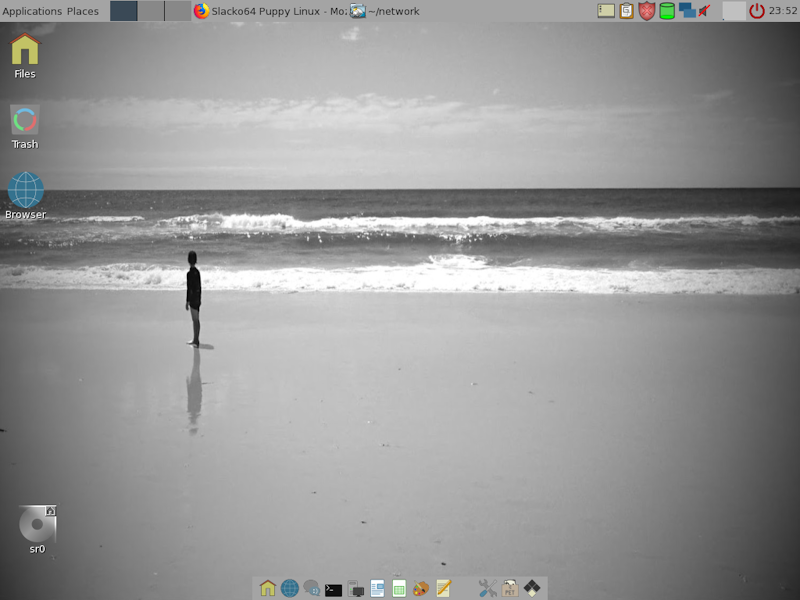Some time ago mister_electronico on the Puppy forum started the discussion of using knobs in gtkdialog code. I gave some feedback but the code never entered a final state. I have now revisited the code, and plan to use it myself.
So, here is a simple test-script to show how it works. All in all, it's just a svg that rotates the dot to show the changing value. Atm, the knob rotates when dragging mouse up/down on the knob. Maybe this should be extended to left/right actions as well. Please check out the code; it should be easy to understand with some basic bash/gtkdialog/svg knowledge.

The code:
#!/bin/bash
export KNOB_WIDTH=120
export KNOB_COLOR="#A5E8B1"
export CARD_NR=0 #'aplay -l' shows your cards
export SPEAKER=Master
#initial audio level
TMP="`amixer -c $CARD_NR get "$SPEAKER" | grep -m1 'Left:' | cut -d '%' -f 1 | cut -d '[' -f 2`" #volume level
ANGLE=$(($TMP*250/100)) #convert from % to angle (0-250)
echo $ANGLE > /tmp/knob_angle
draw_knob (){ #$1=angle/value, $2=width, $3=color, $4=dot-color
echo '
<svg width="'${2}'" height="'${2}'">
<defs>
<radialGradient
cx="'$((${2}*30/100))'" cy="'$((${2}*30/100))'" fx="'$((${2}*30/100))'" fy="'$((${2}*30/100))'" r="'$((${2}*45/100))'"
gradientUnits="userSpaceOnUse">
<stop offset="1"/>
<stop offset="0"/>
</radialGradient>
</defs>
<circle cx="'$(((${2}/2)+(${2}*4/100)))'" cy="'$(((${2}/2)+(${2}*4/100)))'" r="'$((${2}*46/100))'"/>
<circle cx="'$((${2}/2))'" cy="'$((${2}/2))'" r="'$((${2}*46/100))'"/>
<circle cx="'$((${2}/2))'" cy="'$((${2}/2))'" r="'$((${2}*39/100))'"/>
<circle cx="'$((${2}*28/100))'" cy="'$((${2}*74/100))'" r="'$((${2}*4/100))'" transform="rotate('${1}' '$((${2}/2))' '$((${2}/2))')"/>
</svg>'
}
update (){ #get current, relative position of cursor
read ANGLE < /tmp/knob_angle
Y="`getcurpos | awk '{print $2}'`"
read Y2 < /tmp/cursor_y
ANGLE=$(($ANGLE+(($Y2-$Y)*2))) #the knob's value range is equal to moving mouse up/down 125 px.
[ $ANGLE -lt 1 ] && ANGLE=0; [ $ANGLE -gt 250 ] && ANGLE=250 #keep value inside range
echo $Y > /tmp/cursor_y
echo $ANGLE > /tmp/knob_angle
draw_knob $ANGLE $KNOB_WIDTH "$KNOB_COLOR" "#eee" > /tmp/knob.svg
amixer -c $CARD_NR set "$SPEAKER" $(($ANGLE*100/250))%
}
export -f draw_knob update
draw_knob $ANGLE $KNOB_WIDTH "$KNOB_COLOR" "#eee" > /tmp/knob.svg
echo '
<vbox margin="20">
<timer visible="false" milliseconds="true" interval="100" sensitive="false">
<variable>TIMER</variable>
<action>update</action>
<action>refresh:KNOB</action>
</timer>
<eventbox>
<pixmap>
<variable>KNOB</variable>
<input file>/tmp/knob.svg</input>
</pixmap>
<action signal="button-press-event">getcurpos | awk '"'"'{print $2}'"'"' > /tmp/cursor_y</action>
<action signal="button-press-event">enable:TIMER</action>
<action signal="button-release-event">disable:TIMER</action>
</eventbox>
<text><label>Volume</label></text>
</vbox>' | gtkdialog -s
Be aware that this knob depends on the getcurpos command. This is included in all recent Puppies. But I doubt that you'll find getcurpos in most other distros, so I see this as Puppy-code. You should probably avoid this code if you plan to offer your gui outside the kennel.
This info is added to the Tips and tricks post
Edit - Delete
No comments posted yet.


